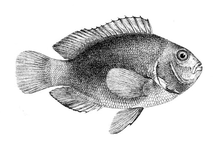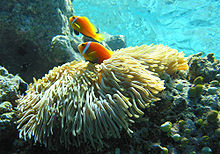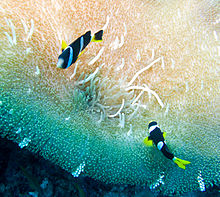Amphiprion
 Amphiprion akindynos | |
| Taxonomia | |
|---|---|
| Superregne | Holozoa |
| Regne | Animalia |
| Fílum | Chordata |
| Classe | Actinopteri |
| Ordre | Perciformes |
| Família | Pomacentridae |
| Subfamília | Amphiprioninae |
| Gènere | Amphiprion Bloch i Schneider, 1801 |














Amphiprion és un gènere de peixos de la família dels pomacèntrids i de l'ordre dels perciformes.[1] Són coneguts, popularment, com a peixos pallasso.
Morfologia
[modifica]- Segons l'espècie en qüestió, poden ésser de color groc, taronja, vermell o negre, i molts mostren taques o línies de color blanc.
- La llargària varia entre 10-18 cm.[2]
Reproducció
[modifica]Depenent de l'espècie, poden pondre centenars o milers d'ous en qualsevol superfície plana a prop de l'anemone que els hostatja. En estat salvatge, els peixos pallasso fresen en l'època de la lluna plena i el mascle protegeix els ous fins que es desclouen entre 6 i 10 dies més tard (generalment, dues hores després del capvespre).[2]
Alimentació
[modifica]Són omnívors: a la natura mengen aliments vius com a algues, plàncton, mol·luscs, crustacis (copèpodes i misidacis) i aliment no digerit per les anemones que els serveixen d'amfitrions. En captivitat, es nodreixen d'escates de peix, musclos i calamars trossejats, bledes, espinacs i, fins i tot, fruites com el kiwi.[2][3]
Distribució geogràfica
[modifica]Es troben a les aigües càlides dels oceans Índic i Pacífic, incloent-hi la Gran Barrera de Corall i la Mar Roja.[2]
Costums
[modifica]En llurs hàbitats naturals, tenen relacions simbiòtiques amb anemones de mar: el peix es nodreix de matèria sense digerir que, altrament, podria danyar l'anemone de mar, mentre que els excrements del peix pallasso proporcionen nutrients a l'anemone de mar. A més, l'activitat natatòria del peix es tradueix en una major circulació d'aigua al voltant de l'anemone de mar i aquesta proporciona seguretat al peix a causa del seu verí que actua de manera dissuasiva davant dels atacs potencials dels depredadors.[2]
Vida en captivitat
[modifica]Els peixos pallasso van ésser el primer tipus de peixos ornamentals marins a ser criats en captivitat amb un èxit total.[2]
Taxonomia
[modifica]- Amphiprion akallopisos (Bleeker, 1853)[4]
- Amphiprion akindynos (Allen, 1972)[5]
- Amphiprion allardi (Klausewitz, 1970)[6]
- Amphiprion barberi (Allen, Drew & Kaufman, 2008)[7]
- Amphiprion bicinctus (Rüppell, 1830)[8]
- Amphiprion chagosensis (Allen, 1972)[5]
- Amphiprion chrysogaster (Cuvier, 1830)[9][10]
- Amphiprion chrysopterus (Cuvier, 1830)[11]
- Amphiprion clarkii (Bennett, 1830)[12]
- Amphiprion ephippium (Bloch, 1790)[13][14]
- Amphiprion frenatus (Brevoort, 1856)[15]
- Amphiprion fuscocaudatus (Allen, 1972)[5]
- Amphiprion latezonatus (Waite, 1900)[16]
- Amphiprion latifasciatus (Allen, 1972)[5]
- Amphiprion leucokranos (Allen, 1973)[17]
- Amphiprion mccullochi (Whitley, 1929)[18]
- Amphiprion melanopus (Bleeker, 1852)[19]
- Amphiprion nigripes (Regan, 1908)[20]
- Amphiprion ocellaris (Cuvier, 1830)[11]
- Amphiprion omanensis (Allen & Mee, 1991)[21]
- Amphiprion percula (Lacépède, 1802)[22]
- Amphiprion perideraion (Bleeker, 1855)[23]
- Amphiprion polymnus (Linnaeus, 1758)[24]
- Amphiprion rubrocinctus (Richardson, 1842)[25]
- Amphiprion sandaracinos (Allen, 1972)[5]
- Amphiprion sebae (Bleeker, 1853)[26]
- Amphiprion thiellei (Burgess, 1981)[27]
- Amphiprion tricinctus (Schultz & Welander, 1953)[28]
- Amphiprion tunicatus (Cuvier, 1830)[11][29][30][31][32][33][34]
Referències
[modifica]- ↑ The Taxonomicon (anglès)
- ↑ 2,0 2,1 2,2 2,3 2,4 2,5 «Amphiprion (Genus)» (en anglès). ZipcodeZoo.com. Arxivat de l'original el 5 d’octubre 2010. [Consulta: 25 juliol 2009].
- ↑ AQUANOVEL Arxivat 2009-07-27 a Wayback Machine. (castellà)
- ↑ Bleeker, P. 1853. Diagnostische beschrijvingen van nieuwe of weinig bekende vischsoorten van Sumatra. Tiental V-X. Natuurkd. Tijdschr. Neder. Indië v. 4: 243-302.
- ↑ 5,0 5,1 5,2 5,3 5,4 Allen, G. R. 1972. The Anemonefishes. Their classification and biology. T. F. H. Publ., Inc. The Anemonefishes: 1-288.
- ↑ Klausewitz, W. 1970. Amphiprion allardi n. sp., ein neuer Anemonfisch von der ostafrikanischen Küste (Pisces: Pomacentridae). Senckenb. Biol. v. 51 (núms. 3/4): 181-192.
- ↑ Allen, G.R., Drew, J. & Kaufman, L. 2008. Amphiprion barberi, a new species of anemonefish (Pomacentridae) from Fiji, Tonga, and Samoa. aqua International Journal of Ichthyology, 14 (3): 105-114.
- ↑ Rüppell, W. P. E. S. 1828-1830. Atlas zu der Reise im nördlichen Africa. Fische des Rothen Meeres. Frankfurt-am-Main. Fische Rothen Meeres 1828-1830: 1-141 + 3 pp., col. Pls. 1-35.
- ↑ Cuvier, G. & A. Valenciennes. 1830. Histoire naturelle des poissons. Tome cinquième. Livre cinquième. Des Sciénoïdes. Hist. Nat. Poiss. v. 5: i-xxviii + 1-499 + 4 pp., Pls. 100-140.
- ↑ Astakhov, D. A. 1996: Discovery of Amphiprion chrysogaster (Pomacentridae) on the barrier reef of Tulear (southwestern Madagascar). Voprosy Ikhtiologii v. 36 (núm. 6): 843-846. (en rus, traducció a l'anglès al Journal of Ichthyology v. 36 (núm. 9):804-807).
- ↑ 11,0 11,1 11,2 Cuvier, G. & A. Valenciennes. 1830. Histoire naturelle des poissons. Tome cinquième. Livre cinquième. Des Sciénoïdes. Hist. Nat. Poiss. v. 5: i-xxviii + 1-499 + 4 pp., Pls. 100-140.
- ↑ Bennett, J. W. 1828-1830. A selection from the most remarkable and interesting fishes found on the coast of Ceylon. Londres. Fishes of Ceylon First Edition: i--viii + 30 unnumbered pp., Pls. 1-30.
- ↑ Bloch, M. E. 1790. Naturgeschichte der ausländischen Fische. Berlín. Naturg. Ausl. Fische v. 4: i-xii + 1-128, Pls. 217-252.
- ↑ Allen, G. R. i V. G. Springer, 1975: Amphiprion calliops Schultz, a junior synonym of the red saddleback anemonefish, Amphiprion ephippium (Bloch). Tropical Fish Hobbyist v. 23 (núm. 9): 53-57.
- ↑ Brevoort, J. C. 1856. Notes on some figures of Japanese fish taken from recent specimens by the artists of the U. S. Japan Expedition. Pp. 253-288, Pls. 3-12 (color) A M. C. Perry, Narrative of the Expedition of an American Squadron to the China Seas and Japan, performed in the years 1852, 1853, and 1854 under the command of Commodore M. C. Perry, United States Navy, by order of the Government of the United States. Vol. 2. U.S. Senate Ex. Doc. Núm. 79, 33rd Congress, 2nd Session. Beverley Tucker, Washington DC, Perry Exped. v. 2: (i-viii) + 1-414 + 1-14 + I-XI + [1], 17 folded charts, Pls.
- ↑ Waite, E. R. 1900. Additions to the fish-fauna of Lord Howe Island. Rec. Aust. Mus. v. 3 (núm. 7): 193-209, Pls. 34-36.
- ↑ Allen, G. R. 1973. Amphiprion leucokranos, a new species of pomacentrid fish, with notes on other anemonefishes of New Guinea. Pac. Sci. v. 27 (núm. 4): 319-326.
- ↑ Whitley, G. P. 1929. Some fishes of the order Amphiprioniformes. Mem. Queensl. Mus. v. 9 (pt 3): 207-246, Pls. 27-28.
- ↑ Bleeker, P. 1852. Nieuwe bijdrage tot de kennis der ichthyologische fauna van Amboina. Natuurkd. Tijdschr. Neder. Indië v. 3: 545-568.
- ↑ Regan, C. T. 1908. Report on the marine fishes collected by Mr. J. Stanley Gardiner in the Indian Ocean. Trans. Linn. Soc. London (Ser. 2, Zool.) v. 12 (pt 3): 217-255, Pls. 23-32.
- ↑ Allen, G. R. 1991. Damselfishes of the world. Mergus Publishers, Melle, Alemanya. Damselfishes of World: 1-271.
- ↑ Lacépède, B. G. E. 1802. Histoire naturelle des poissons. Hist. Nat. Poiss. v. 4: i-xliv + 1-728, Pl. 1-16.
- ↑ Bleeker, P. 1855. Bijdrage tot de kennis der ichthyologische fauna van het eiland Groot-Obij. Natuurkd. Tijdschr. Neder. Indië v. 9: 431-438.
- ↑ Linnaeus, C. 1758. Systema Naturae, Ed. X. (Systema naturae per regna tria naturae, secundum classes, ordines, genera, species, cum characteribus, differentiis, synonymis, locis. Tomus I. Editio decima, reformata.) Holmiae. Systema Nat. ed. 10 v. 1: i-ii + 1-824.
- ↑ Richardson, J. 1842. Contributions to the ichthyology of Australia. (Continued from p. 218.). Ann. Mag. Nat. Hist. (N. S.) v. 9 (núm. 59): 384-393.
- ↑ Bleeker, P. 1853. Diagnostische beschrijvingen van nieuwe of weinig bekende vischsoorten van Batavia. Tiental I-VI. Natuurkd. Tijdschr. Neder. Indië v. 4: 451-516.
- ↑ Burgess, W. E. 1981. Pomacentrus alleni and Amphiprion thiellei, two new species of pomacentrids (Pisces: Pomacentridae) from the Indo-Pacific. Trop. Fish Hobby. v. 30 (núm. 3): 68-69, 72-73.
- ↑ Schultz, L. P. 1953. Review of the Indo-Pacific anemone fishes, genus Amphiprion, with descriptions of two new species. Proceedings of the United States National Museum v. 103 (núm. 3323): 187-201, Pls. 9-10.
- ↑ AQUATAB.NET
- ↑ FishBase (anglès)
- ↑ Catalogue of Life[Enllaç no actiu] (anglès)
- ↑ Dictionary of Common (Vernacular) Names (anglès)
- ↑ BioLib (anglès)
- ↑ Practical Fishkeeping[Enllaç no actiu] (anglès)
Bibliografia
[modifica]- Allen, Gerald R.: Die Anemonenfische- Arten der Welt. Mergus Verlag GmbH (1985) ISBN 3-88244-004-X.
- Den Hartog, J. C., 1997: Notes on the genus Amphiprion Bloch & Schneider 1801 (Teleostei: Pomacentridae) and its host sea anemones in the Seychelles. Zoologische Mededelingen (Leiden) v. 71 (núm. 1-18): 181-188.
- Eschmeyer, W. N. Genera of Recent Fishes (en anglès). iii + 697. Acadèmia de les Ciències de Califòrnia, 1990. ISBN 0-940228-23-8.
- Eschmeyer, W. N. Catalog of Fishes (en anglès). Acadèmia de les Ciències de Califòrnia, 1998. ISBN 978-0-940228-47-4.
- Fautin, Dapne, G. i Allen, Gerald, R.: Anemonenfische und ihre Wirte. Tetra-Verlag (1994), ISBN 3-89356-171-4.
- Helfman, G. S.; Collette, B. B.; Facey, D. E. The Diversity of Fishes (en anglès). Blackwell Science, 1997. ISBN 9780865422568.
- Kuwamora, T., Nakashima, Y. 1998. "New aspects of gender change among reef fishes: recent studies in Japan. Environmental Biology of Fishes. 52:125-135.
- Mebs, D. 1994. "Anemonefish symbiosis: Vulnerability and Resistance of Fish to the Toxin of the Sea Anemone.” Toxicon. Vol. 32(9):1059-1068.
- Mori, K. 1966: A new anemone fish, Amphiprion amamiensis, n. sp. from Japan. Report of Faculty of Fisheries Prefectural University of Mie v. 5 (núm. 3): 469-472.
- Moyle, P.; Cech, J. Fishes: An Introduction to Ichthyology (en anglès). 4a edició. Prentice Hall, 2000. ISBN 9780130112828.
- Nelson, J. S. Fishes of the World (en anglès). 3a edició. Wiley, 1994. ISBN 978-0-471-54713-6.
- Schlegel, H. i S. Müller, 1839: Overzigt den uit de Sunda en Moluksche zeeën bekende visschen, van de geslachten Amphiprion, Premnas, Pomacentrus, Glyphisodon, Dascyllus en Heliases. Verhandelingen over de natuurlijke geschiedenis der Nedertaldsche overzeesche bezittingen / door de Leden der Natuurkundige Commissie in Indië en andere schrijvers; uitgegeven ... door C. J. Temmincki 1839-1844: 17-26, Pls. 4-6.
- Schultz, L. P. 1966: A new anemone fish, Amphiprion calliops from the Indo-Pacific Oceans. Ichthyologica, the Aquarium Journal v. 37 (núm. 2): 71-76.
- Wheeler, A. The World Encyclopedia of Fishes (en anglès). 2a edició. Macdonald, 1985. ISBN 978-0356107158.
Enllaços externs
[modifica]- Dr. Pez (castellà)

